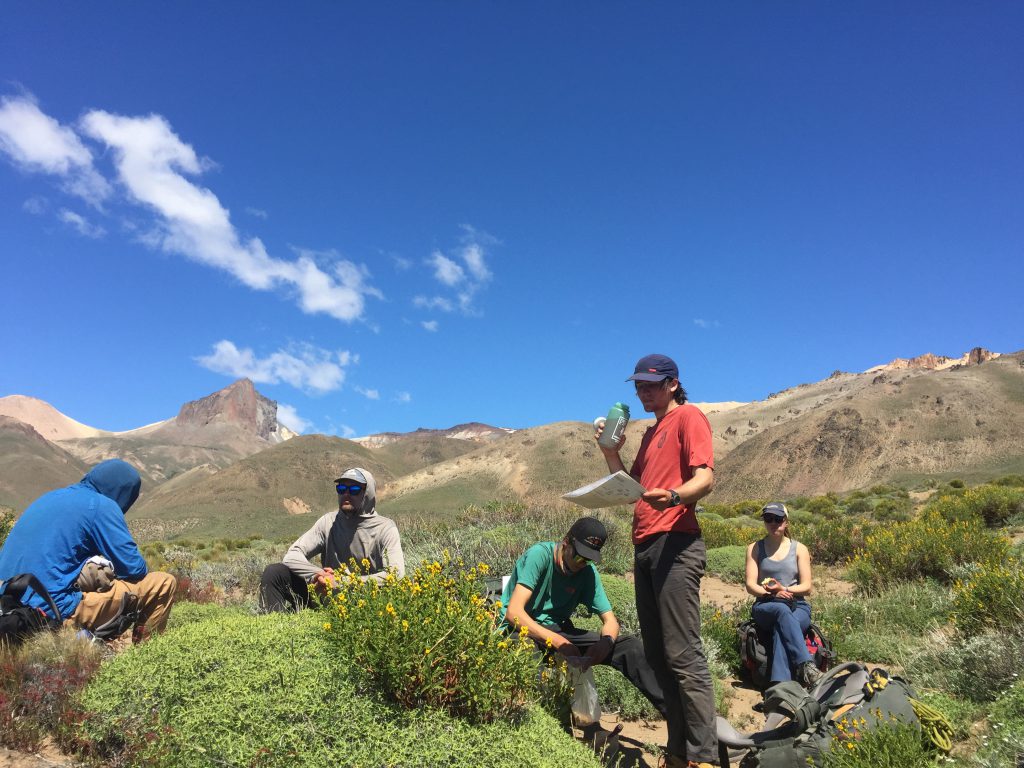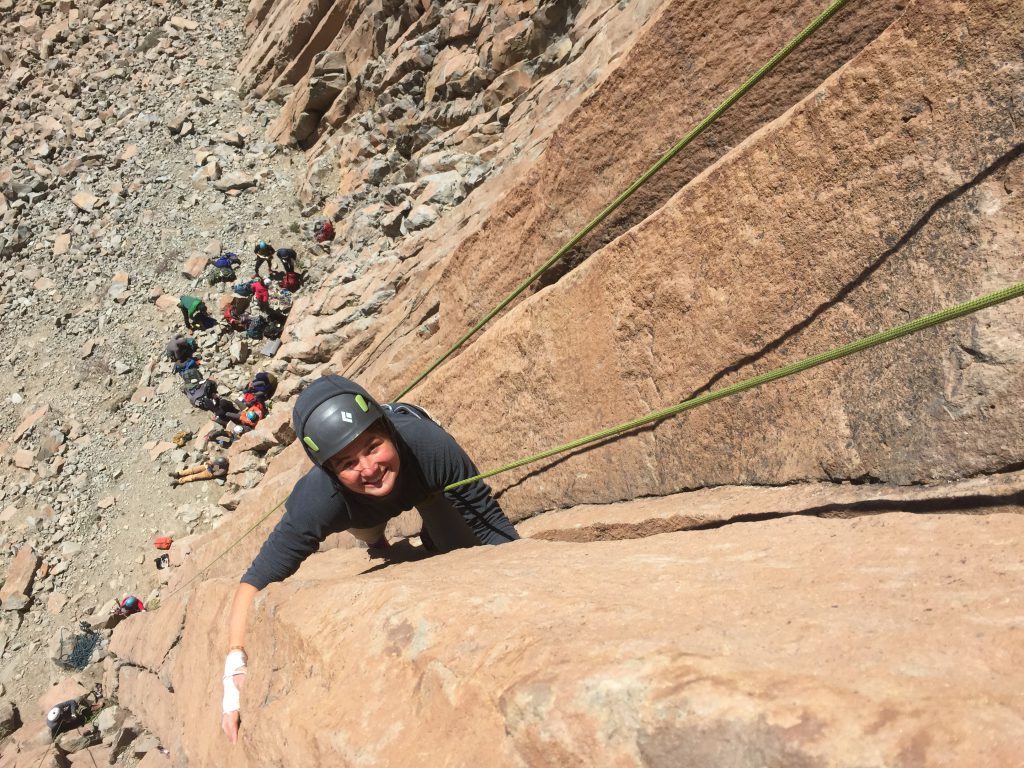Written by: Josh and Laria
I’ve been horizontal for 11 hours and caught about 5 hours of sleep. The wind has been assaulting our “tent” for about 14 hours. It’s a good thing Flynn was running around all night keeping the tent on the ground, or it would been long gone. I deglaze my eyes and take a peep outside, where I can see the rolling hills of Argentina on the horizon. I can see the pond where a pink flamingo landed yesterday. And I can see our cook site snuggled up against a hill. It’s my day to cook so I leave the relative safety of the circus tent and amble outside. I dismantle our storm-proofed kitchen and immediately start boiling some water for our new favorite drink, yerba mate, a very common tea with a strong cultural tradition in Patagonia. For today’s breakfast is a backpacking classic: oatmeal, complete with chocolate, brown sugar, cinnamon and milk powder. We all take down our continental breakfast and meet up with the group. The leaders of the day split us up into self sufficient hiking groups and my group starts walking first.
We take a break to look at our topographic map. The best maps available in Chile are a 1:54000 scale. Using these, it is way more difficult to tell where we are, but we do our best. About 3 hours of hiking later and some feedback for Jake, we stare down a saddle that must be the last major obstacle of the day. We scope out a route and get after it. We can hear what sounds like a jet coming from one of the adjacent peaks but Brad, one of our instructors, assures us it is only 60 MPH winds. We proceed, but very wearily. Within 200 feet of the saddle we are starting to really feel the wind. Brad screams to me to get some momentum, and then launches into the brunt of it. We all march at a 45 degree angle to keep from blowing away. Through “wind tears” I can see Brad and Flynn crawling over the highest part of the summit. It’s like trying to walk through a river. I narrowly escape the jerk of the wind and meet up with the others in a drainage. We breathe a collective sigh of relief and make sure nobody was actually blown away.
About 30 minutes later, we stroll into the destination for the day’s hike. We have to wait for the other group to arrive before we can take the jaunt to the actual camp site. As we wait, we boil water and have another round of mate in equally traditional Patagonia weather.
We make sure to set up our tent diligently this time to avoid another sleepless night. The rain has mutated into snow, so my tent group hides in our tent while Flynn takes another one for the team and cooks outside. After a hearty dinner we talk about each others days and play a game of hearts. Tomorrow we’ll cross a snow-covered saddle to make the final hike to Cerro Colorado.
Our basecamp at Cerro Colorado proves to be just as challenging as the hike to get there, yet we were still able to enjoy our time climbing in this beautiful place. After a few days, the rain clouds cleared, and we were lucky to receive some gorgeous conditions. It stayed warm and dry for the rest of our time, and even the powerful, constant wind that this region is known for abated to almost nothing.
Cerro Colorado is an awe-inspiring, and intimidating, feature with sweeping columned faces seeming to stretch forever. The rock is columnar basalt, formed by volcanic ash as it cooled. The result is thousands upon thousands of geometric pillars that press together to form a climber’s dream: cracks, dihedrals, roofs, chimneys, aretes, and more.
After spending a day adjusting to the unique conditions and climbing style of Cerro Colorado, we spent our week pursuing individualized goals surrounding different climbing objectives. We worked on single pitch routes, continued our traditional climbing progression, and quested up multi-pitch routes in small groups. We continued to refine our crack climbing techniques as well, and adjust to the textured surface of volcanic rocks. It was challenging to learn such unique and unfamiliar climbing terrain, but we enjoyed exploring all that it offers.
When not climbing, we got into the rhythm of backcountry life and playing endless group games. We also participated in several classes, taught by instructors and students alike: Patagonia ecology, “passion” classes (a student-led poetry workshop and a presentation of neural networks in computer science), and continued discussions of environmental ethics. One of these discussions compared Ethan Linck’s article “Your Stoke Won’t Save Us” and Louise Geltman’s “Actually – I Think Stoke Will Save Us.” We debated the outdoor industry’s impact, or lack thereof, on meaningful environmental conservation efforts.
We experienced the product of these conservations efforts during our entire time hiking and climbing, within the recently established Parque Nacional Patagonia. Enfolded in the ridges and ravines, horses and cows roam freely alongside native guanacos. This species of wild llamas has recovered greatly within the park, in the wake of barbed wire removal. In the turbulent winds surrounding Cerro Colorado, condors soar in huge circles. With their wingspans reaching up to ten feet, they are are a fascinating presence there. Looking around mid-climb to find them at eye level, hovering in the wind to study us, was exhilarating.
After soaking in as much as we could, our time there came to an end. On Sunday, after a very full week of climbing, classes, and weather, we said goodbye to Cerro Colorado and began our long trek back to Chile Chico. We were grateful to arrive back at the hostel to enjoy all of its comforts (beds, hot showers, cookies from the supermercado) and to reconnect with family and friends. We definitely learned a lot about overcoming adversity. Still, even the “type two” fun made this expedition our most rewarding yet.


